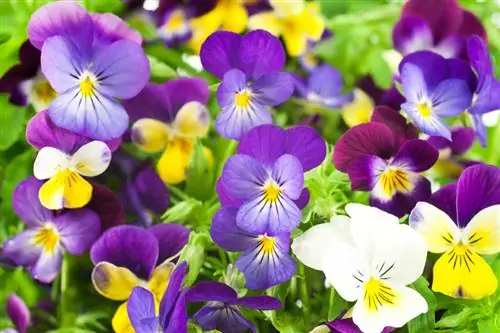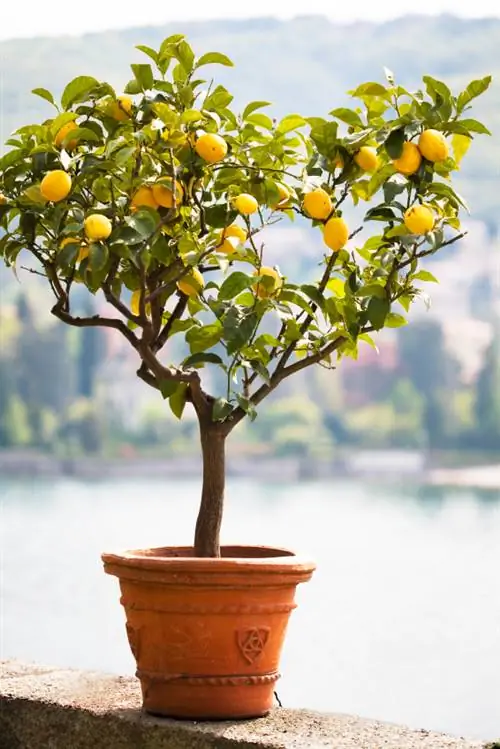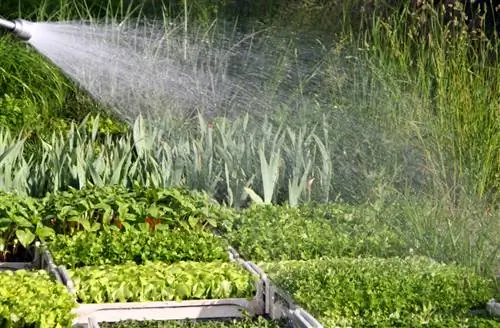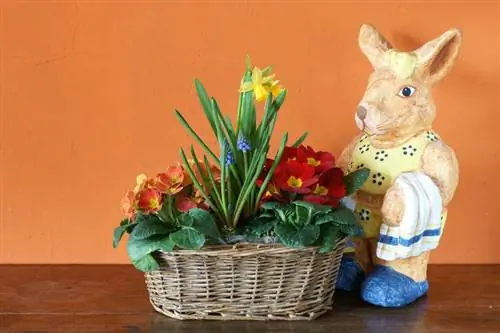- Author admin [email protected].
- Public 2023-12-25 17:45.
- Last modified 2025-06-01 06:02.
They smile flirtatiously at us with colorful flower faces and spread a good mood in the bed and on the balcony. Pansies are indispensable for the creatively designed garden. It's a good thing that the neat violets are so easy to care for.
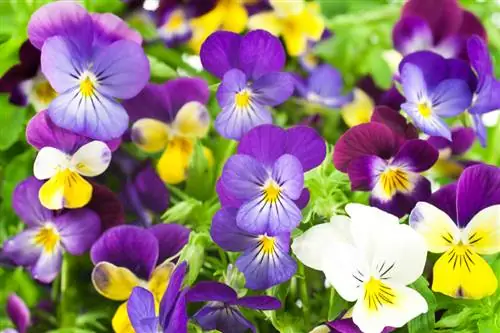
How to care for pansies in the garden?
Pansies are biennial, easy-care plants that are best planted in August. They prefer a sunny to partially shaded location in nutrient-rich, loose soil. Fertilize regularly during the flowering period and remove spent flowers to encourage re-blooming.
Planting pansies correctly
August is the optimal time to plant ready-made pansies. Anyone who misses this date will plant the flowers in the ground in April/May. How to do it right:
- Weed the bed thoroughly, loosen it up and till it into fine crumbs
- Dig small pits at a distance of 20 cm and enrich the soil with compost
- Unpot the pansies, plant them up to the bottom pair of leaves and water them
An organic mulch layer has a beneficial effect on rooting. In addition, watering should be repeated, especially if there is no rain, so that the tender roots establish themselves quickly.read more
Care tips
In order for pansies to show their most beautiful side, they do not require extensive care. The pretty faces value this:
- If the soil dries, water it directly to the roots
- During the growing season until the end of the flowering period, fertilize organically every 4 weeks
- Cut out spent pansies for magnificent rebloom
- Light winter protection in the bed is only required in the event of clear frost in the form of a cover of leaves or brushwood
If you cultivate the violets in a pot, overwintering outdoors will be a bad thing. It's better to put the containers away before the first frost and take them outside again when the temperatures rise.read more
Which location is suitable?
The garden pansy prefers a sunny to partially shaded location in order to perfectly showcase its floral talents. This is best done in nutrient-rich, humus-rich soil that is not too dry. The crumb should be loose and permeable so that waterlogging does not occur when it rains. In the balcony box and pot, the flower tolerates common compost-based container plant substrate to which you add some sand or perlite.read more
The correct planting distance
Arrange pansies in the bed with a planting distance of 15 to 20 cm from each other. In this way, each specimen can develop unhindered without creating unsightly gaps. In the balcony box, reduce the distance between the plants by around 5 cm to create an opulent look.
What soil does the plant need?
Don't let your pansies starve, because they require plenty of nutrients for their colorful flowers. Therefore, choose a location with deep, fresh, moist and nutritious soil. If in doubt, optimize the soil condition by adding compost, bark humus, horn shavings or leaf compost. You can loosen heavy clay-based soil in no time by mixing in a handful of sand.
What is the best time to plant?
Since pansies mostly thrive as biennial plants, choosing the right planting date becomes the focus. How to do it right:
- Growing in seedbeds or greenhouses in June/July, planting in August
- Sowing directly into the bed in July or August
- Plant finished plants from the garden center in August
Alternatively, grow pansies on the windowsill in February/March to plant them in April/May. However, these plants do not have the robust constitution of violets grown outdoors and planted in late summer.
When is flowering time?
The chosen planting date defines the flowering time. If the weather conditions are suitable, pansies planted in August bloom for the first time in October, only to repeat their flower festival next spring starting in March. If Grim Reaper stays at home in winter, well-cared for violets will bloom tirelessly and will not take a winter break. If you regularly cut out spent stems, the striking flowers will decorate the garden well into the summer. If they have had enough opportunity to seed, the offspring will follow the two-year-old Violas on the heels of them.read more
cutting pansies correctly
The violets leave the decision to the gardener. You can let nature take its course and remove pruning from your care program. In this case, you will of course not like the appearance of the wilted, sadly drooping flowers. To enjoy neat pansies with a never-ending flowering period and a well-kept garden look, the scissors are used like this:
- Clean out faded pansies regularly
- Cut close to the ground at the end of the first flowering period in winter or early spring
In the second year, do the same thing, but now the plants are given the opportunity to multiply by seed. Therefore, do not cut off all the withered flower stalks as soon as possible, but leave about a third in the bed for the formation of seed heads.
Watering pansies
Pansies prefer a balanced water balance both in the bed and in the planter. A constantly light substrate that dries out slightly in the meantime meets the requirements perfectly. Please note that drought stress is the most common problem for flowers during the winter period. Therefore, water on frost-free days if there is no snow in winter.
Fertilize pansies properly
With organic fertilizer you can meet the nutrient needs of pansies in an exemplary manner. Compost, horn shavings, guano, bark humus and plant manure contain all the important ingredients for vital growth and a lush bloom. Starting fertilization at the beginning of budding should be refreshed repeatedly every 4 weeks until the flowering period ends.read more
Diseases
If he alth problems arise with pansies, the fungal infection mildew is usually behind it. The plant disease, which is widespread in the garden, manifests itself in the form of a mealy-gray patina on the upper and lower sides of the leaves. If you experience this symptom, do not hesitate, but cut out all infected parts of the plant immediately. Treat the remaining violets repeatedly with a spray of 1 part fresh milk (not long-life milk) and 9 parts water. The lecithin contained in milk has an effective and defensive effect on fungal spores.read more
Pests
The juicy foliage and delicate flowers are unfortunately the favorite food of voracious snails. To prevent the pests that are omnipresent in your home garden from feasting on your lovingly grown pansies, you can ward off the pest like this:
- Collect the cold-hardened snails with tongs early in the morning
- Lay out moving barriers around the bed made of sharp materials, such as chippings or sawdust
- Collect, dry and scatter coffee grounds as they have a toxic effect on snails
Any snail infestation in the garden is a thing of the past if you can house Indian runner ducks there. If the cute beneficial insects have a garden pond and winter quarters within the fenced area available, they will enthusiastically hunt the slimy pests all day long and eat them with great pleasure.
Wintering
The wild form of pansies (Viola tricolor) can withstand temperatures down to -30 degrees Celsius. The resulting garden pansy (Viola wittrockiana) with its diverse varieties is at least frost-resistant down to -23 degrees. These ideal values apply to typical snowy weather in a partially shaded location in nutrient-rich, permeable soil. If there is no protective blanket of snow in the bitter frost, we recommend taking the following precautions:
- Pile up garden pansies in the bed with leaves and conifers
- Cover with breathable garden fleece
- Water on frost-free days, provided there is no rain or snow
In the balcony box or bucket there is always a need for winter protection so that the small root balls do not freeze. Cover the containers with foil and slide a wooden block underneath. Small pots with a diameter of less than 30 cm move to frost-free, bright winter quarters.read more
Propagate pansies
For the ambitious hobby gardener, it is a matter of honor to propagate his most beautiful pansies on his own. The following methods are available for this purpose:
- Harvesting the seeds and sowing behind glass or in the bed from June
- Dividing the root ball in spring or autumn
- Cut off runners, let them root in pots and plant out
Since harvesting the tiny pansy seeds requires a fair amount of tact and strong nerves, we recommend purchasing certified seeds (€2.00 on Amazon) from specialist retailers. In this case, you can also be sure in which color the young plants will thrive, which is not the case with seeds you have harvested yourself.read more
How do I transplant correctly?
Since pansies thrive as biennial plants, the effort of transplanting them is not worth it for either a change of location or rejuvenation. If you want the beautiful faces in another place in the garden, simply sow the seeds there from July or plant ready-made specimens from the garden center in August.
Pansies in a pot
If you fill a pot with drainage at the bottom and potting soil on top, pansies will thrive in it without fail. This is how you care for the beautiful faces in a sunny to partially shaded location:
- Water directly onto the roots when dry
- From the beginning of budding until the end of the flowering period, fertilize liquidly every 2-3 weeks
- Clean up wilted flowers regularly
Before the first frost, move the two-year-old flowers into the bright, frost-free winter quarters. During wintering, water enough to prevent the root ball from drying out and do not give any fertilizer.
How do pansies differ from horned violets
Since horned violets look like little pansies at first glance, both types of plants are often thrown into the same pot. Although both flowers come from the violet family, there are still clear differences that affect care.
- Pansies are biennial plants - horned violets thrive perennial
- Pansies grow up to 30 cm high - horned violets rarely reach 20 cm
- The individual pansy flower is 6 cm tall - horned violet flowers reach 3 cm in diameter
The flower shape of both plant species also shows differences. The pansy boasts 4 petals pointing upwards and 1 pointing downwards, while the spurred horned violet has 3 petals pointing skywards and 2 pointing towards the ground.
Trivia
It seems to have come from the realm of fables and makes plant lovers pay attention in amazement. The pansy orchid actually exists. If you take one look at the tropical flower beauty, the mystery is already solved. The beautiful Miltonia orchid impresses with flowers that have a striking resemblance to a pansy. Botanically, however, there is no relationship between the two plant species.
Beautiful varieties
- Alpine Lake: The pansy stands out with its deep, dark blue, huge flowers; Growth height 15-30 cm
- Evening glow: The burgundy-red flowers with black spots create an elegant look; Growth height 15-30 cm
- Tasty: The pansy for snacking, with slightly ruffled flowers it is also a feast for the eyes; Growth height 15-20 cm
- Joker Poker Face: Novelty with rich orange flowers, edged in dark purple; Growth height 15-20 cm
- Germania: Extremely decorative variety thanks to double flowers and ruffled edges; Growth height 20 cm

